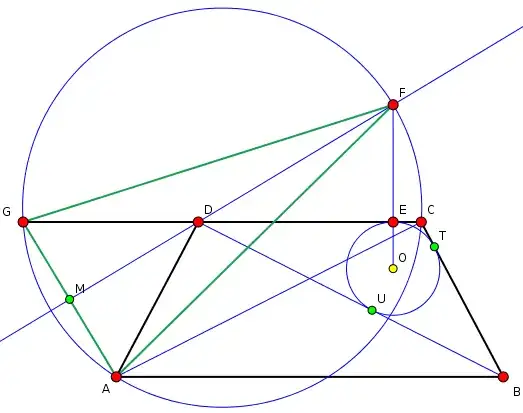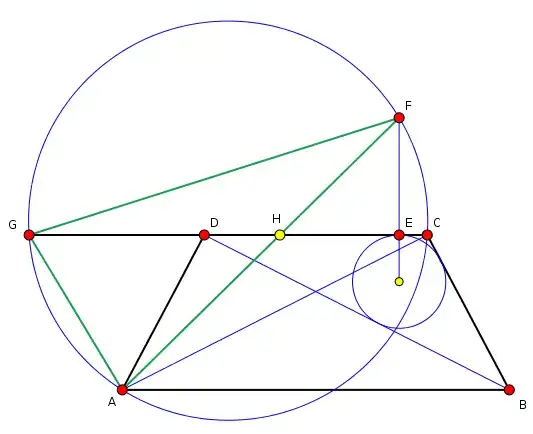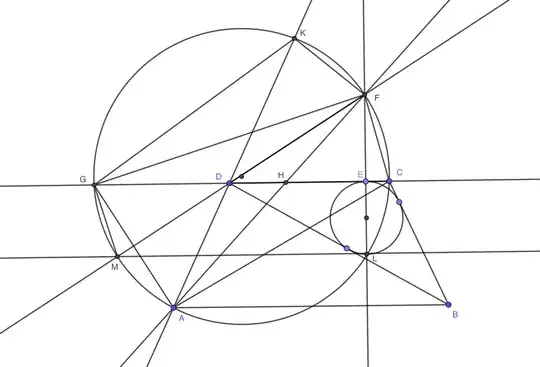When I'm too lazy to find a suitable chain of established theorems, I tend to resort to algebraic computations. I like using homogeneous coordinates and projective geometry for this. I dislike square roots, as you'd get them when computing the incircle from the circumscribed triangle. So I'll start with that incircle. Without loss of generality, the incircle of $\triangle BCD$ is the unit circle, with $E=[0:1:1]$ at the top to match the figure. Then the other two points of contact can be chosen using the tangent half-angle formulas in such a way that they can represent any point on the unit circle except $E$.
$$E=\begin{bmatrix}0\\1\\1\end{bmatrix}\qquad
T=\begin{bmatrix}2t\\t^2-1\\t^2+1\end{bmatrix}\qquad
U=\begin{bmatrix}2u\\u^2-1\\u^2+1\end{bmatrix}$$

The tangent line at each of these points can be obtained by multiplying the matrix of the unit circle with the vector. Since that matrix is $\operatorname{diag}(1,1,-1)$ (representing $x^2+y^2-1=0$) you simply negate the last coordinate. Then the points where the tangents intersect can be computed as cross products between the lines.
\begin{align*}
B&\sim\begin{bmatrix}2t\\t^2-1\\-t^2-1\end{bmatrix}\times\begin{bmatrix}2u\\u^2-1\\-u^2-1\end{bmatrix}=2(t-u)\begin{bmatrix}t+u\\tu-1\\tu+1\end{bmatrix}\\
C&\sim\begin{bmatrix}2t\\t^2-1\\-t^2-1\end{bmatrix}\times\begin{bmatrix}0\\1\\-1\end{bmatrix}=2\begin{bmatrix}1\\t\\t\end{bmatrix}\\
D&\sim\begin{bmatrix}2u\\u^2-1\\-u^2-1\end{bmatrix}\times\begin{bmatrix}0\\1\\-1\end{bmatrix}=2\begin{bmatrix}1\\u\\u\end{bmatrix}
\end{align*}
Assuming $T\neq U$ and therefore $t\neq u$, we can cancel all these coefficients in front of the vectors and continue calculations with the simple representatives. Next we need a reflection in the symmetry axis of the trapezium. You could compute this as the uniquely defined projective transformation which exchanges $C$ with $D$ and exchanges the ideal circle points $I=[1:i:0]$ and $J=[1:-i:0]$ (which is the mark of any orientation-reversing similarity). But I'd rather avoid the complex numbers here, and instead go with the inhomogeneous transformation
$$\begin{pmatrix}P_x\\P_y\end{pmatrix}\mapsto
\begin{pmatrix}C_x+D_x-P_x\\P_y\end{pmatrix}=
\begin{pmatrix}\frac1t+\frac1u-P_x\\P_y\end{pmatrix}$$
Written in homogeneous coordinates and avoiding divisions by multiplying everything with $tu$ this becomes $P\mapsto RP$ with the reflection matrix
$$R=\begin{bmatrix}-tu&0&t+u\\0&tu&0\\0&0&tu\end{bmatrix}$$
We can use this to find $A$ as
$$A=RB=\begin{bmatrix}t+u\\tu(tu-1)\\tu(tu+1)\end{bmatrix}$$
To compute the angular bisector through $A$ would again entail a square root, but we can also define that same line as the line through $A$ and the reflection of the origin $O=[0:0:1]$ (which is the center of the incircle).
$$l_{AF}\sim A\times(RO)=tu\begin{bmatrix}tu(tu-1)\\tu(t+u)\\(t+u)(1-tu)\end{bmatrix}$$
This line we intersect with $[1:0:0]$, the vector for the line $1x+0y+0=0$, to obtain $F$.
$$F\sim\begin{bmatrix}tu(tu-1)\\tu(t+u)\\(t+u)(1-tu)\end{bmatrix}\times\begin{bmatrix}1\\0\\0\end{bmatrix}=-(t+u)\begin{bmatrix}0\\tu-1\\tu\end{bmatrix}$$
Omitting this factor $t+u$ here assumes $t\neq-u$ or in other words $T,U$ are not mirror images with respect to the vertical axis through the unit circle. If they were, then $A$ and $B$ would be the same point, so I think this is again a fair assumption.
Now we need the circle through $A,C,F$, which can be computed as the conic through $A,C,F,I,J$ with $I=[1:i:0]$ and $J=[1:-i:0]$ as the ideal circle points. First define two degenerate conics through $A,C,I,J$, each given as the symmetric product of a pair of (complex) lines. Then the circle is the linear combination which also passes through $F$.
$$
Q_1=(I\times A)\odot(J\times C)=\tfrac12\bigl((I\times A)(J\times C)^T+(J\times C)(I\times A)^T\bigr) \\
Q_2=(J\times A)\odot(I\times C)=\tfrac12\bigl((J\times A)(I\times C)^T+(I\times C)(J\times A)^T\bigr) \\
Q\sim(F^TQ_2F)Q_1-(F^TQ_1F)Q_2=i u t^3 (u^2 + 1)\cdot\\
\begin{bmatrix}
2 u t^2 (tu + 1) &
0 &
-t^2 (u^2 + 1) \\
0 &
2 u t^2 (tu + 1) &
-t (2t^2u^2 + u^2 - 1) \\
-t^2 (u^2 + 1) &
-t (2t^2u^2 + u^2 - 1) &
2 u (tu - 1) (t^2 + 1)
\end{bmatrix}$$
I have to concede that this circle is quite a beast. We have non-degeneracy conditions $t\neq 0$ and $u\neq 0$, since either of these would lead to one tangent being parallel to $CD$ and this to points at infinity. The point $G$ can be computed as
$$G\sim (D^TQD)C - 2(C^TQD)D=2(t-u)^2
\begin{bmatrix}t-u\\tu(tu+1)\\tu(tu+1)\end{bmatrix}$$
Now we need to express the isosceles condition. One possibility: $F$ lies on the orthogonal bisector of $AG$. To describe that bisector you can join the midpoint $M$ between $A$ and $G$ to the point $N$ at infinity orthogonal to $AG$.
$$M\sim G_3A+A_3G=2t^2u(tu+1)\begin{bmatrix}1\\tu^2\\u(tu+1)\end{bmatrix}\\
N\sim\begin{bmatrix}1&0&0\\0&1&0\\0&0&0\end{bmatrix}(A\times G)=
-2tu^2(tu+1)\begin{bmatrix}t\\1\\0\end{bmatrix}$$
Now three points are collinear if their determinant is zero.
$$\det(F,M,N)=\begin{vmatrix}
0 & 1 & t \\
tu-1 & tu^2 & 1 \\
tu & u(tu+1) & 0
\end{vmatrix} = 0$$
So $F$ does indeed lie on the perpendicular bisector, as claimed. Q.e.d.


